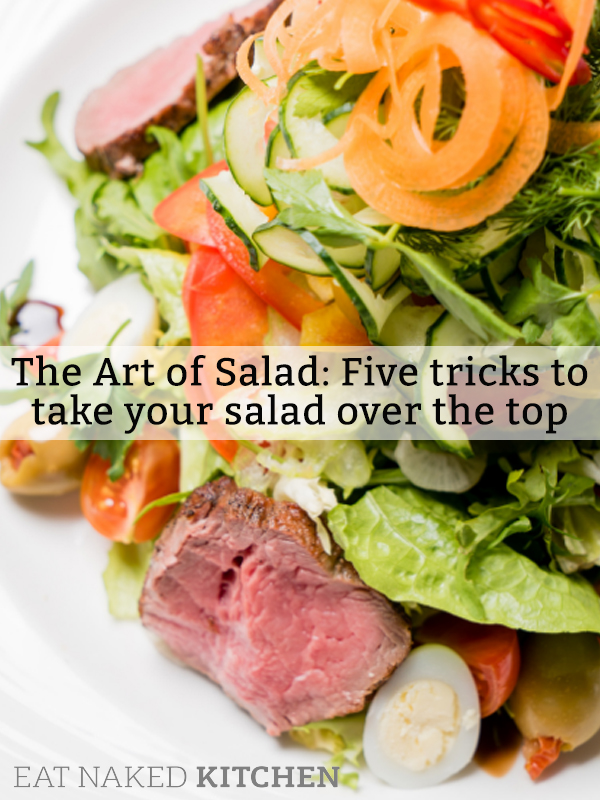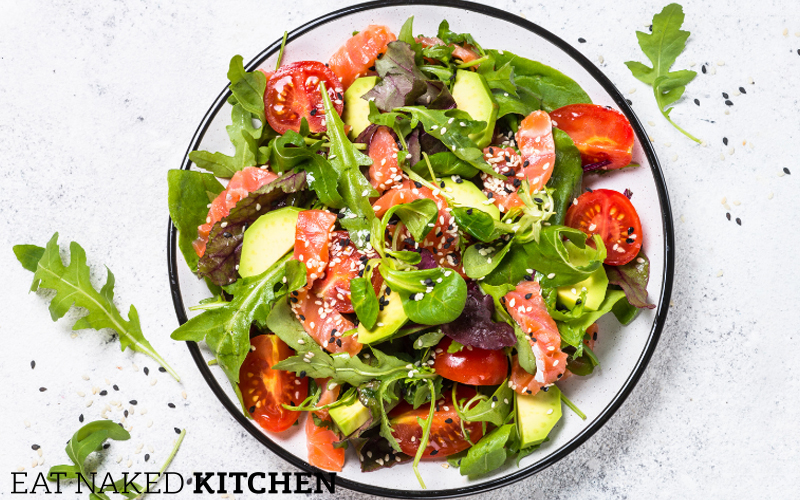
Written by Chef James
Salads have come far from the iceberg lettuce, tomato and vinaigrette days of yesteryear. As a child, I wouldn’t have anything to do with salads. My “salad” was eating a carrot. Now ask me my favorite item to make, and I’ll say salad dressings. I love a good salad.
By definition, salad is a cold, usually raw mix of vegetables with a dressing that are eaten as just one part of a larger meal. In more recent times, salads have become complicated, stand alone meals.
As a salad connoisseur there are certain considerations that I believe can make or break a salad. Follow these five criteria and step into salad mastery:
1) Quality, seasonal produce.
Since most salads are raw, you want flavorful vegetables that are grown using no synthetic pesticides, herbicides, or fertilizers. If they are locally grown and seasonal, all the better as they’ll be harvested when ripe. Eating seasonally will automatically add variety into your salads as you use different ingredients based on what’s available that time of year. This will also help you out of the rut we all get into using the same old ingredients every time.
2) Variety and color.
When eating a salad as your main meal, variety and color are your friends. Who wants to eat a boring, neutral looking salad? Colors like red, yellow and purple will make your salad pop! When shopping, let you eyes lead you in the right direction. Choose vegetables of different colors.
3) Texture.
A salad without a crunch is just a soggy mess. Look for varied textures as you prepare your salad. Wash and spin your lettuce to revive it and bring out its crispness. Add some nuts or seeds for some extra crunch, add cheese for something salty and soft, and add cultured vegetables or olives for something a little sour.
4) Size matters.
I’m a big believer that no one should need a knife to eat a salad. Small bite size cuts are ideal. A chiffonade or julienne cut where you cut the lettuce into thin bite size strips makes for a salad that can be a) eaten without a knife and b) can absorb and be easily coated by the dressing.
5) Dressing.
If you’re using bottle dressing on your salad, then please stop. As a salad nazi – I mean connoisseur – I require that all dressings are made from scratch. (For easy to make dressings that take only 5-10 minutes to make and can be used repeatedly, check out The Naked Foods Cookbook here). Bottled salad dressings use cheap oils, are preservative filled, and use over-processed ingredients. They’re also a main source of added sugar and salt. Just don’t use them. Make your own dressings and control the quality of the ingredients. It can be as simple as cold-pressed extra virgin olive oil, with fresh herbs and lemon or lime juice. Use real ingredients and your body will love you for it.
Margaret’s note: Some people skip the dressing or look for ‘fat free’ dressings to skimp on calories. This is a big no-no with salads. You need the fats in the oil in order to absorb the nutrients in the vegetables, and if it’s a good quality oil, you don’t have to worry about a negative impact on your body. Furthermore the fats make the salad taste so much better, they fill you up and they give you long lasting energy that will help you stay full until the next meal. So don’t be shy – dress your salad!!
Here’s a simple guideline to use when making your next salad:
Market Salad
Ingredients:
- 2 cups lettuce or light, leafy greens like romaine, red lettuce, spinach or arugula
- 2 oz of a homemade dressing (see The Naked Foods Cookbook for ideas)
- 3 oz protein of choice like grassfed beef or smoked salmon (this is a great use of leftovers from dinner). If vegan, choose beans or lentils over tofu.
- 1/2 cup medley of vegetable toppings like diakon radish, carrots, beets, cucumber or tomatoes
- 1 tablespoon of a nut or seed like pumpkin seeds or sesame seeds
- 1 tablespoon of choice cheese like shaved parmesan, raw milk cheddar or goats cheese (If not eating dairy, use capers, olives or other similar product)
- 1 teaspoon garnish of fresh chopped herbs like chives, parsley, thyme or basil
There you have it. Try your best to bust loose of adding processed ingredients to your salad. That includes no croutons, bacon bits, pita, or crispy noodles. Seaweed, nuts, and seeds can add the right crunch to a salad so you don’t feel like you’re missing out.





I, for one, have tasted many of Chef James’s salads….and they are delicious! I used to be a salad cutter myself (which often elicited some strange looks from others), always struggling to make those perfect bites to get all the goodness of my salad into my mouth – so when I found that someone else had the same philosophy about cutting the lettuce, I was delighted! Thanks for getting it out there! And all the other tips are super helpful too. Here’s to turning the world into salad lovers 🙂
I was delighted to find a kindred salad spirit as well, Leslie! Thanks for posting.
Chef James’ Umiboshi dressing (from Eat Naked cookbook) is our absolute favorite dressing for salads.